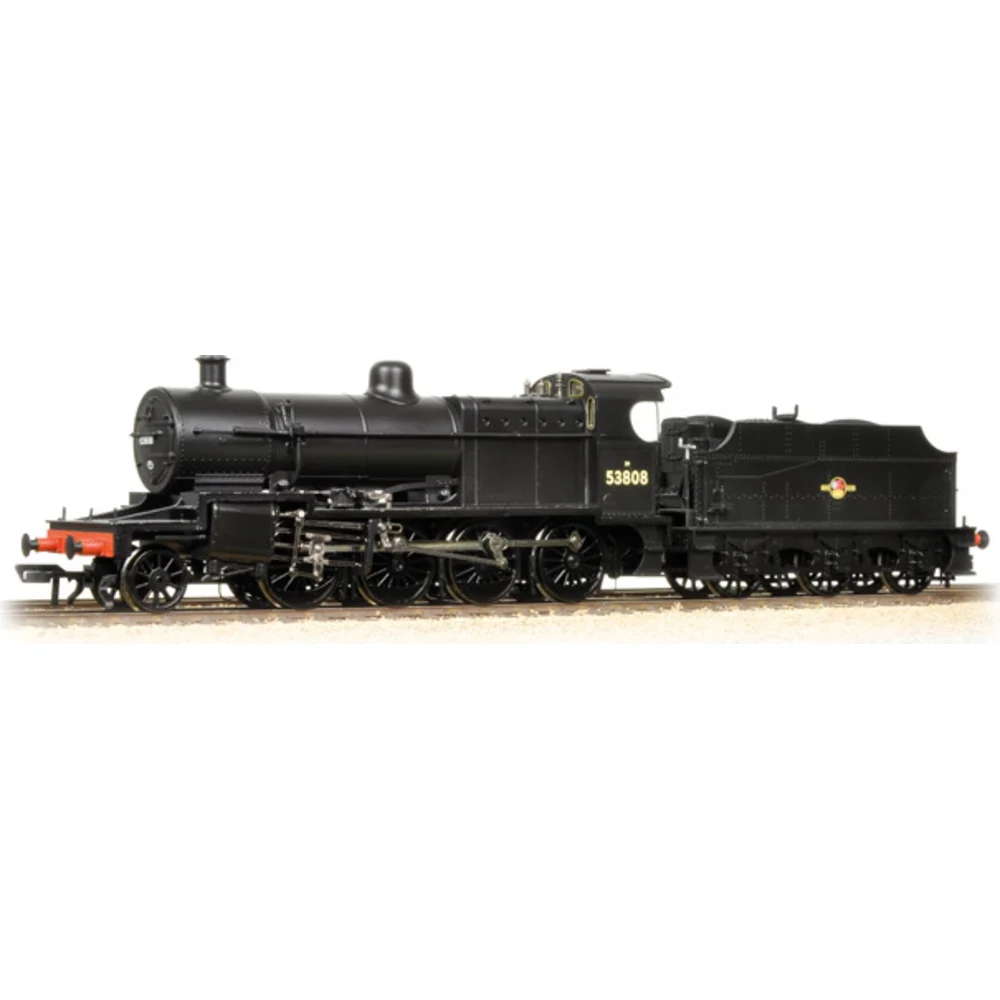Bachmann 31-013
Somerset & Dorset Joint Railway 7F 2-8-0 53808 British Railways Black with Late Crest
Tooling
The Bachmann Branchline Somerset & Dorset Joint Railway (S&DJR) 7F 2-8-0 was first introduced in 2010, marking a significant addition to the OO gauge market. This model represents the powerful freight locomotives designed specifically for the steep gradients of the S&DJR, originally built in 1914 and 1925. The tooling was developed to capture the distinctive features of these locomotives, which were among the most powerful mineral engines of their time.
Tooling Features
- Scale: OO Gauge (1:76 scale)
- Construction: Die-cast chassis with plastic body shell
- Detailing: High-fidelity detailing including separately fitted handrails, brake rigging, and pipework. Some models include etched plates and Deeley tenders.
- Couplings: NEM pockets with tension-lock couplers; cosmetic screw-link couplers included in accessory packs
Mechanical & Electrical
- Motor: Centrally mounted motor driving the main driving wheels via a gear train
- Minimum Radius: Recommended second radius curves (approx. 18 inches / 450 mm)
- Lighting: No factory-fitted lighting
- Weighting: Heavily weighted chassis for improved traction and realistic performance
DCC Capability
- Interface: DCC Ready with 21-pin socket
- Decoder Installation: Decoder fits in the tender; blanking plug included for DC operation
Liveries Produced
- S&DJR black (pre-grouping)
- LMS black (1923–1947)
- BR black with early emblem (1949–1957)
- BR black with late crest (1957–1968), including weathered variants
- Special edition: S&DJR blue for the 150th anniversary
Reviews & Commentary
The model received positive reviews for its accuracy, smooth running, and attention to detail. It was praised for capturing the rugged character of the prototype and for its reliable performance on layouts. Some early DCC installations encountered issues with decoder compatibility, but these were resolved with proper fitting and updated chips.
Media & Social Media
The S&DJR 7F tooling has featured in various YouTube videos and enthusiast forums, often showcased hauling heavy freight on heritage-style layouts. It was also highlighted in the UKTV series "Hornby: A Model World," where its sound-equipped variant was demonstrated using recordings from preserved locomotives.
Additional Notes
Accessory packs typically include etched plates, vacuum pipes, and optional detailing parts. The model is not suitable for children under 14 due to its fine detailing and small components.
Class & Prototype
- Class: Somerset & Dorset Joint Railway 7F 2-8-0
- Traction: Steam
- Built: 1914-1925
- Total Built: 11
No prototype found.
Operator & Livery
- Operator: British Railways
- Livery: Black with Late Crest
British Railways transformed Britain's fragmented rail network into a unified national system following nationalisation on 1st January 1948. Created from the "Big Four" companies under the Transport Act 1947, BR operated most of Great Britain's railways until rebranding as British Rail in 1965, managing over 20,000 route miles and inheriting nearly 20,000 locomotives of diverse designs.
The organisation pioneered standardisation through its revolutionary BR Standard locomotive programme (1951-1960), producing 999 advanced steam engines under Robert Riddles' direction. These included the versatile Britannia Pacifics, mighty 9F freight engines, and mixed-traffic classes that incorporated the best features from all predecessor companies. The 1955 Modernisation Plan accelerated diesel and electric traction development, creating fascinating mixed-traction operations.
Notable achievements included establishing unified locomotive classification systems, introducing distinctive corporate liveries, and managing the complex transition from steam to modern traction. BR's six regional structure preserved operational diversity whilst enabling standardisation of practices, signalling, and rolling stock that had eluded private enterprise for over a century.
The BR era represents steam traction's final flowering alongside emerging diesel technology, creating unparalleled locomotive variety. Today, this heritage remains highly popular with railway enthusiasts through extensive preserved fleets, heritage railway operations, and comprehensive model ranges from manufacturers like Hornby, Bachmann, and Dapol, making BR subjects essential for authentic post-war British railway modelling across all scales.
British Railways' plain black livery remained the standard finish for freight and shunting locomotives from 1956 onwards, representing the most economical and practical scheme for inherently dirty industrial operations. Plain black locomotives retained red buffer beams and received white lettering in Gill Sans style, maintaining the utilitarian approach established in the early BR period. The livery was applied to a vast range of locomotive types, from powerful freight engines like the 9F class down to humble shunting locomotives and industrial engines working in goods yards, collieries, and freight terminals.
From 1956, these locomotives received the new "Lion and Crown" emblem (nicknamed the "Ferret and Dartboard"), a proper heraldic device featuring a rampant lion emerging from a crown and holding a spoked wheel, enclosed in a roundel with "British Railways" displayed on bars either side. Unlike earlier practice, the new emblem was positioned centrally on tender sides or tank sides without reference to axle boxes, following heraldic conventions with the lion facing left. This livery period coincided with increasing neglect as steam operations wound down, with locomotives often covered in layers of grime that obscured the paintwork and made the already austere black finish appear even more weathered. The plain black finish continued until individual locomotives were withdrawn from service, with many examples lasting into the final years of steam operation in 1968. For modellers, this livery represents the twilight of steam freight operations, capturing the workaday reality of British Railways' industrial locomotive fleet during the final phase of steam traction.
